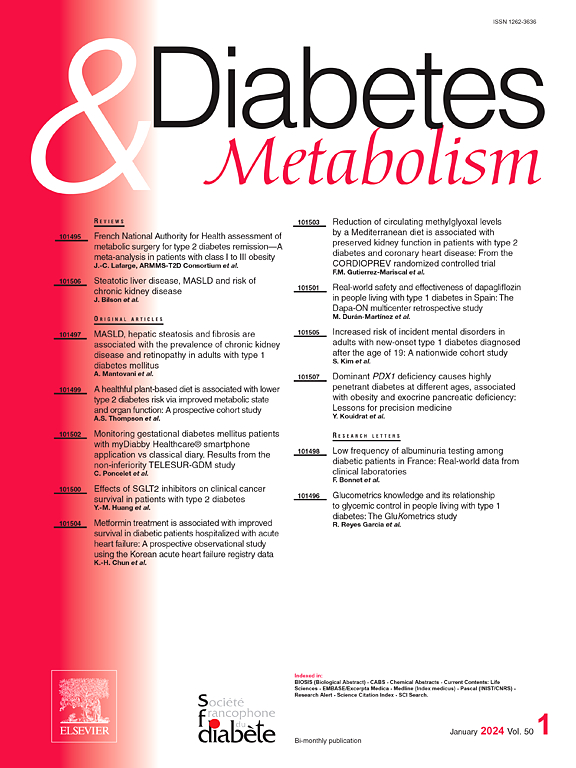Mitochondrial heteroplasmy-phenotype correlation and response to glucose lowering therapy in subjects with m.3243A>G mutations
IF 4.7
2区 医学
Q1 ENDOCRINOLOGY & METABOLISM
引用次数: 0
Abstract
Introduction
There is a paucity of evidence to guide pharmacological treatment for mitochondrial diabetes. Metformin is generally contraindicated due to the high risk of lactic acidosis, Sulphonylurea (SU) therapy has been used as 1st line therapy but most progress to insulin. The aim of this study is to investigate the glucose-insulin secretory response to oral glucose, the response to glucose lowering therapy, and the heteroplasmy phenotype correlation in subjects with a confirmed m.3243A>G mutation.
Methods
49 subjects were phenotyped in detail. A 2 hr OGTT was performed to establish insulin-secretory response. Heteroplasmy was measured and they had bi-annual clinical follow-up.
Results
34 of 49 m.3243A>G subjects had diabetes mellitus (DM) with an onset at 38 (31–44) years, 7 had impaired glucose tolerance or impaired fasting glucose, and 8 had normal glucose tolerance (NGT). DM subjects had reduced insulin secretion (AUC C-peptide 2009.0[1710.0–3156.0] vs. 4693.75[3768.25–5609.38] pmol/l/120 min, P = 0.002) and insulin sensitivity (OGIS 283.0[209.0–324.0] vs. 437.0 [416.0–524.0]ml min−1m−2, P < 0.001]) compared to NGT subjects. Heteroplasmy was higher in DM subjects compared to NGT (20[11–26] vs. 6[5–10] %, P = 0.014). 5 of 8 subjects on metformin had raised lactate and 65 % of subjects required insulin to improve glycaemic control. Only 1/6 subjects transitioned from insulin to SU. Two subjects on SGLT2i and GLP-1 agonists progressed to insulin.
Conclusion
β-cell dysfunction and insulin resistance contribute to mitochondrial diabetes development. 65 % of subjects required insulin to improve glycaemic control. Early insulin initiation may be necessary to improve glycaemic control in the long term.
m.3243A > G突变受试者的线粒体异质性-表型相关性和对降糖治疗的反应
导言:缺乏证据来指导线粒体糖尿病的药物治疗。二甲双胍因乳酸性酸中毒的危险性高而被普遍禁用,磺脲类(SU)治疗已被用作一线治疗,但多数进展为胰岛素治疗。本研究的目的是探讨口服葡萄糖对葡萄糖-胰岛素分泌的反应,对降糖治疗的反应,以及确认m.3243A >g突变的受试者的异质性表型相关性。方法:对49例患者进行详细表型分析。进行2小时OGTT以确定胰岛素分泌反应。测量异质性,并进行两年一次的临床随访。结果:49例m.3243A > G受试者中有34例糖尿病(DM),发病时间为38.0(31.0-44.0)岁,7例糖耐量受损或空腹血糖受损,8例糖耐量正常(NGT)。糖尿病患者胰岛素分泌(AUC c肽2009.0[1710.0-3156.0]比4693.75[3768.25-5609.38]pmol/l/120min, P = 0.002)和胰岛素敏感性(OGIS 283.0[209.0-324.0]比437.0 [416.0-524.0]ml min-1m-2, P < 0.001)较NGT组降低。糖尿病患者的异质性高于非糖尿病患者(20[11-26]比6[5-10]%,P = 0.014)。服用二甲双胍的8名受试者中有5名乳酸水平升高,65%的受试者需要胰岛素来改善血糖控制。只有1/8的受试者从胰岛素过渡到SU, 2名使用SGLT2-I和GLP-1激动剂的受试者进展到胰岛素。结论:β细胞功能障碍和胰岛素抵抗与线粒体糖尿病的发生有关。65%的受试者需要胰岛素来改善血糖控制。从长期来看,早期胰岛素治疗对于改善血糖控制是必要的。
本文章由计算机程序翻译,如有差异,请以英文原文为准。
求助全文
约1分钟内获得全文
求助全文
来源期刊

Diabetes & metabolism
医学-内分泌学与代谢
CiteScore
12.00
自引率
4.20%
发文量
86
审稿时长
13 days
期刊介绍:
A high quality scientific journal with an international readership
Official publication of the SFD, Diabetes & Metabolism, publishes high-quality papers by leading teams, forming a close link between hospital and research units. Diabetes & Metabolism is published in English language and is indexed in all major databases with its impact factor constantly progressing.
Diabetes & Metabolism contains original articles, short reports and comprehensive reviews.
 求助内容:
求助内容: 应助结果提醒方式:
应助结果提醒方式:


